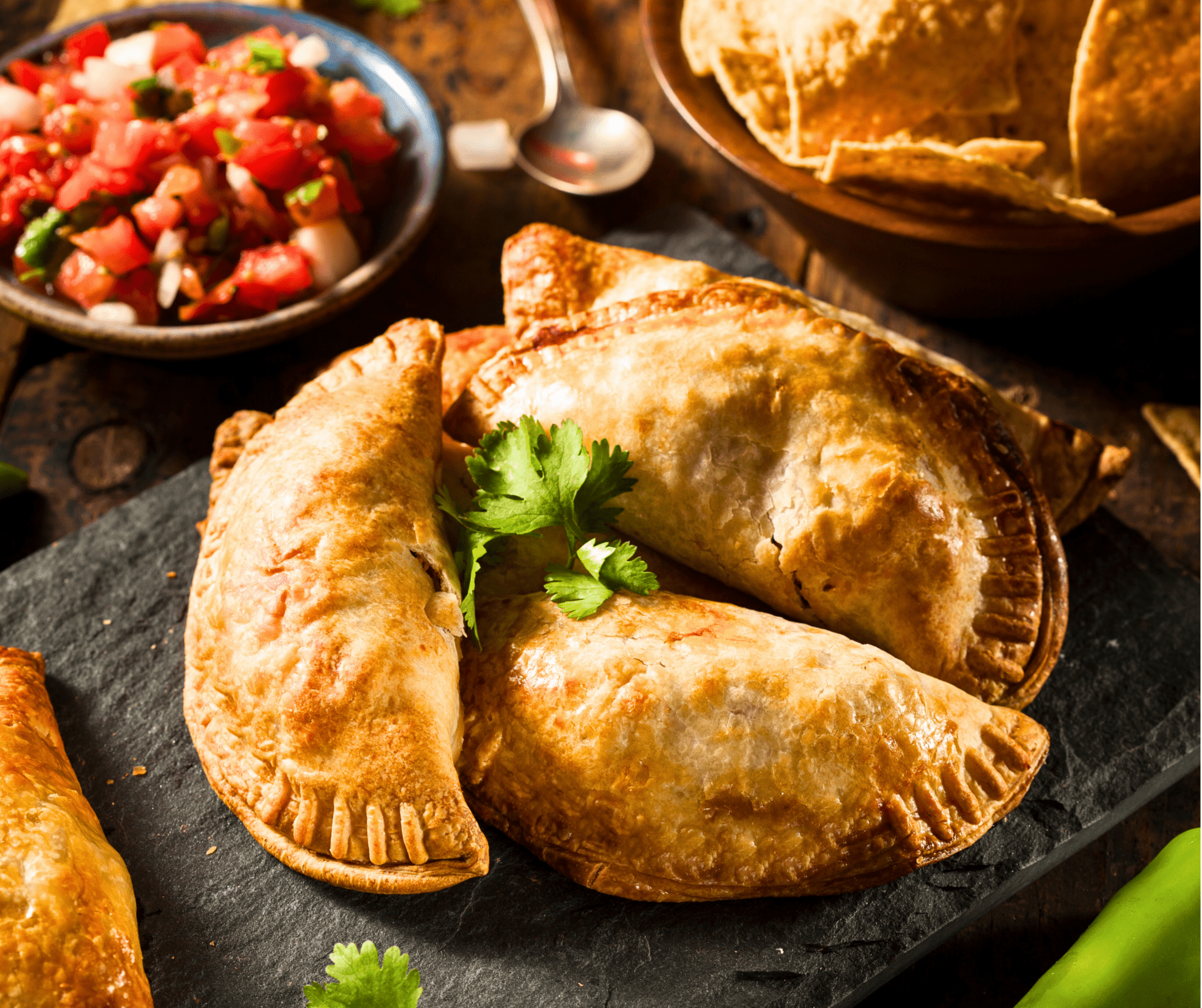Empanadas are a culinary delight that transcend borders and cultures, capturing the hearts and taste buds of people around the world. Originating from the Iberian Peninsula, these savory turnovers have evolved into a beloved dish with numerous regional variations. Whether filled with tender beef, spicy vegetables, or a combination of ingredients, empanadas offer a perfect balance of crispy pastry and flavorful fillings. This recipe for beef empanadas highlights the timeless appeal of this versatile dish, providing a detailed guide to creating delicious, homemade empanadas that are sure to impress family and friends.
Full Recipe:
Empanada Dough
Ingredients:
- 3 cups all-purpose flour
- 1/2 teaspoon salt
- 1/2 cup unsalted butter, cold and cut into small pieces
- 1 large egg
- 1/2 cup cold water (plus more if needed)
- 1 tablespoon white vinegar (optional, helps with dough elasticity)
Instructions:
- Mix Dry Ingredients:
- In a large bowl, combine the flour and salt.
- Cut in Butter:
- Add the cold, diced butter to the flour mixture. Use a pastry cutter or your fingers to work the butter into the flour until the mixture resembles coarse crumbs.
- Add Wet Ingredients:
- In a small bowl, beat the egg. Add the egg, cold water, and vinegar (if using) to the flour mixture. Mix until the dough starts to come together.
- Form Dough:
- Turn the dough out onto a lightly floured surface and knead it gently until it forms a smooth ball. If the dough is too dry, add more water, a tablespoon at a time.
- Chill Dough:
- Wrap the dough in plastic wrap and refrigerate for at least 30 minutes to make it easier to roll out.
Beef Filling
Ingredients:
- 1 pound ground beef
- 1 medium onion, finely chopped
- 2 cloves garlic, minced
- 1/2 cup red bell pepper, finely chopped
- 1/2 cup green olives, sliced (optional)
- 1/4 cup raisins (optional)
- 1 tablespoon tomato paste
- 1 teaspoon ground cumin
- 1/2 teaspoon paprika
- 1/2 teaspoon dried oregano
- Salt and black pepper to taste
- 1 large egg, beaten (for egg wash)
- Oil for cooking
Instructions:
- Cook Beef:
- Heat a large skillet over medium heat. Add a bit of oil and cook the ground beef until browned, breaking it up with a spoon as it cooks. Drain excess fat if necessary.
- Add Vegetables:
- Add the chopped onion, garlic, and red bell pepper to the skillet. Cook until the vegetables are softened, about 5 minutes.
- Season Filling:
- Stir in the tomato paste, cumin, paprika, oregano, salt, and black pepper. Cook for another 2-3 minutes to let the flavors meld together.
- Add Optional Ingredients:
- If using, stir in the sliced olives and raisins. Cook for an additional 2 minutes.
- Cool Filling:
- Remove from heat and let the filling cool to room temperature.
Assemble Empanadas
- Preheat Oven:
- Preheat your oven to 375°F (190°C).
- Roll Out Dough:
- On a lightly floured surface, roll out the dough to about 1/8-inch thickness. Use a round cutter or a glass to cut out circles of dough, about 4-5 inches in diameter.
- Fill Empanadas:
- Place a spoonful of the beef filling in the center of each dough circle. Be careful not to overfill.
- Seal Edges:
- Fold the dough over the filling to form a half-moon shape. Press the edges together with your fingers, then crimp with a fork to seal.
- Egg Wash:
- Place the empanadas on a baking sheet lined with parchment paper. Brush the tops with the beaten egg for a golden finish.
- Bake:
- Bake in the preheated oven for 20-25 minutes, or until the empanadas are golden brown.
- Cool Slightly:
- Let the empanadas cool on a wire rack for a few minutes before serving.
Empanadas are a delightful and versatile dish, perfect for a snack, appetizer, or even a meal on the go. These beef empanadas feature a savory filling encased in a flaky, buttery dough. This recipe guides you through making both the dough and filling from scratch, resulting in empanadas that are sure to impress.
1. Preparing the Dough
The dough for empanadas is a key element to their success. It should be tender, flaky, and easy to work with. Start by combining flour and salt in a large bowl. Add cold, diced butter to the mixture. Using a pastry cutter or your fingers, work the butter into the flour until the texture resembles coarse crumbs. This step is crucial for achieving a light and flaky texture in the final product.
Once the butter is incorporated, add beaten egg, cold water, and optionally, vinegar. The vinegar helps the dough stay elastic, making it easier to roll out and handle. Mix until the dough starts to come together, then turn it out onto a floured surface. Knead gently until smooth. Chill the dough in the refrigerator for at least 30 minutes. This rest period helps relax the gluten, making the dough easier to roll and less likely to shrink during baking.
2. Making the Beef Filling
The filling is the heart of the empanada, and it should be rich and flavorful. Start by browning the ground beef in a skillet over medium heat. Drain any excess fat, then add finely chopped onions, garlic, and red bell pepper. Cook until the vegetables are softened and fragrant.
Season the mixture with tomato paste, ground cumin, paprika, oregano, salt, and pepper. These spices create a robust flavor profile that complements the beef beautifully. Optional ingredients like sliced olives and raisins add a touch of extra flavor and texture, but they can be omitted based on personal preference.
Once the filling is well-seasoned and cooked, let it cool to room temperature. This step is important to prevent the dough from becoming soggy when the hot filling is added.
3. Assembling the Empanadas
To assemble the empanadas, roll out the chilled dough on a floured surface to about 1/8-inch thickness. Cut out circles of dough, typically 4-5 inches in diameter. Place a spoonful of cooled beef filling in the center of each dough circle. Be careful not to overfill, as this can make sealing the empanadas difficult.
Fold the dough over the filling to create a half-moon shape. Press the edges together with your fingers and then crimp with a fork to ensure they are well-sealed. This not only helps keep the filling inside but also adds a decorative touch.
Brush the tops of the empanadas with a beaten egg before baking. This egg wash gives the empanadas a beautiful golden color and enhances their appearance.
4. Baking and Serving
Bake the empanadas in a preheated oven at 375°F (190°C) for 20-25 minutes, or until they are golden brown and crisp. Allow them to cool slightly on a wire rack before serving.
Empanadas can be enjoyed warm or at room temperature. They are perfect as a standalone snack, paired with a dipping sauce, or served alongside a fresh salad.
Tips for Success
- Chill the Dough: For best results, make sure to chill the dough. This helps it roll out more easily and prevents it from shrinking during baking.
- Don’t Overfill: Too much filling can make it difficult to seal the empanadas properly and may cause leakage.
- Use a Fork: Crimping the edges with a fork not only seals the empanadas but also creates a decorative pattern that adds to their visual appeal.
Origin and History of Empanadas
Empanadas, a beloved dish enjoyed around the world, have a rich history that spans multiple cultures and continents. Their name derives from the Spanish verb empanar, which means “to bread” or “to wrap in bread,” reflecting the dish’s nature of encasing filling in a pastry shell.
Early Origins
The concept of encasing ingredients in dough is ancient and can be traced back to various cultures. The origins of empanadas are often linked to the medieval Spanish cuisine, particularly in the Iberian Peninsula. The idea of wrapping meat and other fillings in dough was influenced by the Moors, who introduced new ingredients and culinary techniques to Spain during their rule from the 8th to the 15th centuries. These culinary traditions were further refined and adapted by the Spanish.
Spanish Influence
In medieval Spain, empanadas were filled with a variety of ingredients, including meat, fish, and vegetables. They were often prepared for special occasions and festivals. The dish was originally baked, but over time, the method of frying empanadas also became popular. The Spanish settlers carried the recipe with them to the Americas and other parts of the world.
Latin American Adaptations
As Spanish colonists and explorers traveled to the Americas, they brought empanada recipes with them. Local ingredients and culinary traditions influenced the development of empanadas in different regions. For example:
- Argentina: In Argentina, empanadas became a staple of the country’s cuisine. They are often filled with beef, onions, olives, and hard-boiled eggs, reflecting the local flavors and ingredients. Argentine empanadas are typically baked, though some regions prefer frying them.
- Chile: Chilean empanadas are also predominantly filled with beef, but they may include a mixture of onions, hard-boiled eggs, olives, and sometimes even a slice of avocado. Chileans often enjoy empanadas during celebrations like Fiestas Patrias.
- Colombia and Venezuela: In these countries, empanadas are commonly made with corn dough and are often filled with a variety of ingredients such as beef, chicken, or cheese. They are usually fried and served with aji (a spicy sauce) for added flavor.
- Mexico: Mexican empanadas, or empanadas de carne, can be found in various forms. They may be filled with spiced beef or chicken and are often enjoyed as a snack or part of a meal.
Global Spread
As people migrated and cultural exchanges occurred, empanadas spread to various parts of the world, each region adding its own unique twist. In the Philippines, Spanish influences led to the creation of empanadang rellenong baboy, a version filled with pork. In the United States, empanadas have become popular in Latino communities and are increasingly found in mainstream cuisine, often adapted with local flavors and ingredients.
Modern Variations
Today, empanadas are enjoyed globally in many different forms. They can be found in street food markets, restaurants, and even homemade kitchens. The fillings vary widely, ranging from traditional meats and cheeses to innovative combinations of vegetables and international ingredients. Whether baked or fried, empanadas remain a versatile and cherished dish with a rich history that reflects the blending of cultures and culinary traditions.
The enduring popularity of empanadas speaks to their versatility and universal appeal, making them a beloved comfort food in many cultures around the world.
Conclusion
In conclusion, making beef empanadas from scratch is not just about preparing a meal—it’s about embracing a rich culinary tradition that spans centuries and continents. The process of crafting these golden, flaky pastries offers a rewarding experience, blending the savory flavors of a well-seasoned beef filling with the delicate texture of homemade dough. Whether you’re preparing them for a casual family dinner, a festive gathering, or simply to enjoy as a tasty snack, these empanadas are sure to bring a touch of culinary joy to any occasion. By mastering this recipe, you not only create a delicious dish but also connect with a global tradition of flavor and comfort that has delighted palates for generations.






